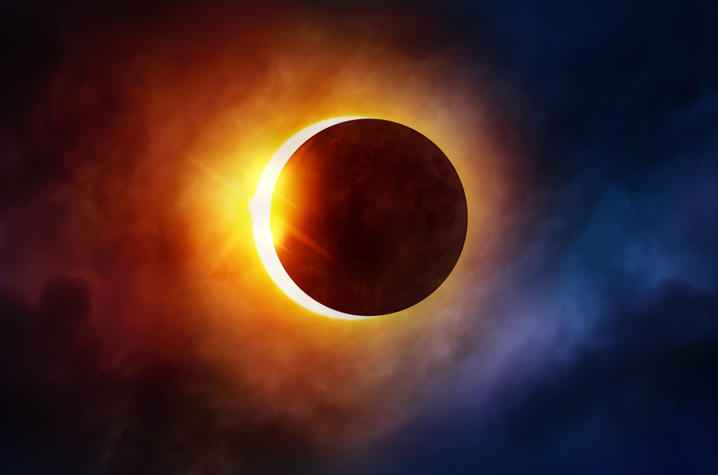See Solar Eclipse Safely, Learn About UK Eclipse Events

LEXINGTON, Ky. (Aug. 17, 2017) — Excitement has been building about the Aug. 21 solar eclipse in Kentucky. It's a rare, wonderful natural phenomenon, yet one that should be experienced safely. Read more below about safety as well as UK events and projects related to the eclipse.
Do not look directly at the sun during any partial phase of the eclipse.
Whether you are inside or outside the area of the total eclipse, when the moon obscures 100 percent of the sun, it is important to take precautions against damaging your eyesight.
Lexington will experience a partial eclipse — 95 percent coverage of the sun. The eclipse will begin around 1 p.m. Monday, reach its peak about 2:30 p.m. and will be complete before 4 p.m.
Proper eyewear is needed to view the eclipse without damaging the retina of your eye. It is critical that you follow all precautions and use the proper eyewear.
Dr. Claire Fraser, assistant professor in UK Advanced Eye Care, explains how unprotected viewing can damage your eyes, and she offers advice for safely viewing the eclipse:
Sunlight can start a fire when focused through a magnifying glass.
The same thing can happen to the part of the eye that senses light, the retina. The eye works to focus light through the pupil onto the retina in the back of the eye. The focused energy of sunlight can permanently destroy the light-sensitive part of the retina at the very center of your vision, which can lead to lasting central vision loss. This can happen over the course of a few seconds of looking at the sun.
Solar retinopathy can occur from sun gazing, as well as welding without proper eye protection and looking directly at high-powered laser pointers.
Use proper protection to view the eclipse.
Solar filters must meet a very specific worldwide standard known as ISO 12312-2.
A number of American manufactures have certified that their eclipse glasses and handheld solar viewers meet this standard:
- American Paper Optics (Eclipser) / EclipseGlasses.com / 3dglassesonline.com
- Celestron (EclipSmart Glasses & Viewers)
- DayStar (Solar Glasses)
- Explore Scientific (Solar Eclipse Sun Catcher Glasses)
- Lunt Solar Systems (SUNsafe SUNglasses)
- Meade Instruments (EclipseView Glasses & Viewers)
- Rainbow Symphony (Eclipse Shades)
- Seymour Solar (Helios Glasses)
- Thousand Oaks Optical (Silver-Black Polymer & SolarLite)
Another option is to use #14 welder’s glass, which is darker than the shade that arc welders typically wear.
Don’t use glasses/viewers if scratched or damaged. Put eclipse glasses on and take off while looking away from the sun. You should not be able to see the landscape through the eclipse glasses.
Never look at eclipse through an unfiltered camera, binoculars, a telescope or other device, even when wearing eclipse glasses. These devices need specially designed lens filters.
For more information visit https://eclipse2017.nasa.gov/ or http://www.aao.org/.
Meanwhile, UK is offering eclipse related events:
Chasing Shadows: The 2017 Total Solar Eclipse in America
Saturday, August 19, 9–9:50 a.m. in 106 White Hall Classroom Building
A speaker from the Department of Physics and Astronomy will present a colorful slide presentation and answer solar eclipse questions: Where do I have to be to see it? How can I watch it safely? When will my next chance be to see a total eclipse? What can I expect to see?
Partial Solar Eclipse Viewing During K Week
Monday, August 21, 1:30– 3 p.m. on Pieratt Fields (Johnson Center Fields)
The Physics and Astronomy Department will be handing out solar eclipse glasses and informational fliers for the partial solar eclipse on August 21. Here at UK the sun will be 95 percent blocked by the moon at 2:30 p.m. (FUSION participants will return from their day of service in time to see the eclipse at the viewing event on Pieratt Fields)
Solar Eclipse Celebration at The Arboretum in Lexington
Monday, August 21, 1-4 p.m. on the lawn outside The Arboretum's Visitor Center
For those who cannot travel out of town, the event will include family activities, and solar glasses will be given to the first 100 participants. The Arboretum, part of the UK College of Agriculture, Food and Environment, is located at 500 Alumni Drive. Bring blankets, chairs and snacks.
Aug. 18-21, offered by West Kentucky 4-H Camp in Dawson Springs, Kentucky — part of UK Cooperative Extension.
The UK College of Engineering is involved in the first ever attempt to live stream a solar eclipse. UK is working with NASA Kentucky on this nationwide project. A team of University of Kentucky students, led by College of Engineering Professor Suzanne Smith, is preparing to launch two high-altitude weather balloons on Aug. 21. Similar teams will be doing the same thing throughout the path of totality of the eclipse across 14 states. If weather and systems cooperate, the balloons will be livestreaming from the edge of space at http://eclipse.stream.live. More information is available at: https://uknow.uky.edu/student-life/uk-students-livestreaming-eclipse-edge-space.
Also in the College of Engineering, the research group, Aggregate.Org, within the Department of Electrical and Computer Engineering, will be using five camera arrays and several independent cameras to capture multispectral high-dynamic range images of the eclipse from two separate Kentucky locations, one in the path of totality, one here in Lexington. The cameras' arrays were designed and built in the group led by Hank Dietz, professor and James F. Hardymon Chair in Networking.
Each array is called a MASK, short for multispectral array solar from Kentucky. These camera arrays and the images they capture are being used in ongoing computational photography research, funded in part by a National Science Foundation grant. A photo of the red MASK can be viewed here: http://aggregate.org/IMG/DSC09307sm.jpg.
UK Professor Tom Troland from the Department of Physics and Astronomy talks more about the eclipse: https://www.youtube.com/watch?v=dpXmSyd8UYY&feature=youtu.be




